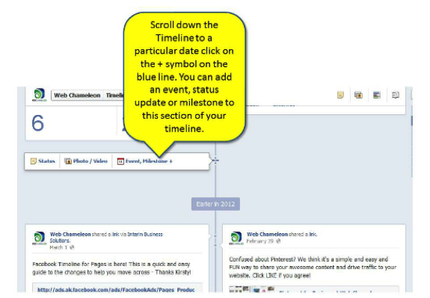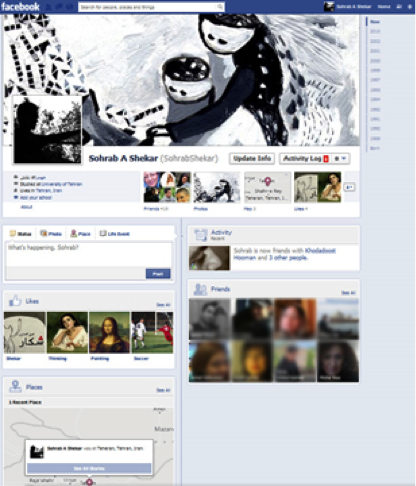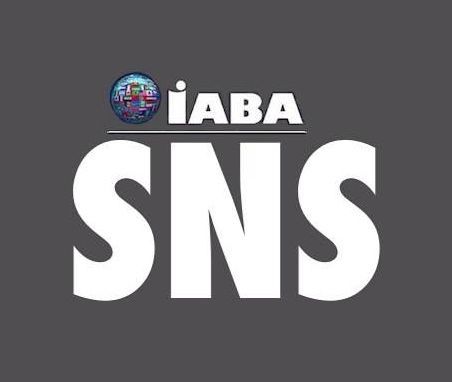Conversations
- The IABA SNS Blog
Hunt: Using Facebook's Timeline as a Platform for Storytelling
When Facebook released its Timeline in late 2011, millions of real life stories were automatically narrated on users’ profiles. Timeline organized the unstructured feed of data that had previously detailed users’ interactions with the social media interface into a chronological autobiography on each profile page. Although many users tried to ignore or avoid the change, the Timeline eventually became an inherent element of the social media network. Now, status updates, life events and other personal material can be traced and categorized, creating a life story for each user.
While Timeline sparked discussions about users’ rights to privacy, for me as a creative writer, it also brought new possibilities for telling stories in a virtual space where lives and stories were being shared and narrated by everyday people. I was inspired to use Facebook to extend the world of my novel Hunt
(2012) by creating a profile for the story’s protagonist Sohrab, a Tehran artist confined to his apartment following a suspicious
disaster. Hunt became a transmedia project that used a printed novel and Facebook’s timeline as dual platforms for storytelling.
It is one of the first (if not the first) projects to use Facebook’s Timeline to build on a fictional work and explore the potential of the social networking site as a space for creative practice. Using both print and digital forms of storytelling, Hunt
addresses the socio-political complications of Iranian society after the presidential election of 2009. Here, I explain how I used Facebook Timeline to expand my novel into a transmedia project, and I consider the perceived gap between analog and digital media as a literary practitioner.
Originally, Hunt
was purely a print publication: a socio-political novel published by the German-based Persian publisher Gardoon in June 2012 [1]. Hunt is set in Iran, my home country, where the protagonist, a painter named Sohrab lives alone in a Tehran apartment building that also houses six other families. Sohrab is working on a painting when toxic air pollution spreads dramatically, endangering the citizens of Tehran. Authorities confine citizens to their homes and other “safe” houses. In the first hours of the disaster, many people are killed by the super toxic air. Those that survive are imprisoned in buildings. All communication ceases. Characters speculate that the pollution is the result of a chemical attack perpetrated by an elusive “enemy” who, according to the government, poses a continual threat: ultimately the characters question whether they are safe at the hands of their government. The story addresses the complicated contemporary political issues of my country through the metaphor of air pollution, and it examines social conflict and the disastrous situation of many people living in Iran during post-election period in 2010.
While I was editing the final version of the novel, I became interested in the new features of Facebook’s Timeline and the creative possibilities they offered. I began to go look more closely at my Timeline and the Timelines of my friends, and I found myself within lots of meaningful life stories. Not everyone had a clear biography or a structured life story, although some biographical aspects could be traced in each page. Others’ Timelines showed well-organized life stories from birth through to the present. In such profiles the user had taken care to satisfy their visitors with a perfect presentation of important dates, personal feelings and experiences by filling in their “About” page and any blank spaces in their Timeline.
I found many Timelines that, in their chronological assemblage of posts, status updates, photos, and life events, gave the impression of short stories. Sometimes, I could find these stories instantly through reading a few consecutive posts, and sometimes I had to use my imagination to fill in the gaps and create a narrative from the fragmentary profiles. These observations led me to start thinking about how I could use this new world in my writing. Imagining Sohrab, my protagonist, as a Facebook user with his own profile, friends, and Timeline opened up new possibilities for expanding my story in Hunt. My mission was to make a fictional and believable profile for Sohrab.

Fig.1. “Facebook Tips: How to add Milestones to your Timeline” [2]
Amongst the capabilities of Facebook’s Timeline is the ability to edit the details of posts and thereby move them back and forth on the timeline: it enables users to add posts to our past. Essentially, we are able to correct or manipulate the history of our personal lives in virtual space. It gives us the ability to design, restructure and represent our autobiographies on Facebook. For example, to alter the date of any important life event, Facebook tells us that the process is as simple as this:
You can change the date of stories on your Timeline, including your life events and any photos and videos you post or are tagged in. This will move the stories to a new spot on your Timeline. To change the date of a story:
1. Hover over the story and click2. Select Change Date3. Enter a new date and click Save [3]
In the first versions of Timeline users could click on any year of their timeline (visualized by a line in the middle of the profile page) and add “stories” instantly (Fig.1). This possibility had a visual attraction and I noticed that this was prompting people to go back and add more to their Timelines in order to fill the gaps between events and statuses.
What I wanted to do though, was to create a Facebook user from scratch, and I decided to use the Facebook Timeline to extend and elaborate on Sohrab’s life. He could then appear as a “friend” to those who had read my novel, inhabiting the same (digital) spaces of their own daily lives: the aim was to make him closer and more tangible for Hunt’s readers.
There were some constraints that I needed to consider; because of the political context around the real life 2010 election, timing and dates were important factors in the story and I needed to make sure that all of the materials I posted on Sohrab’s Timeline followed the logic and aligned with the events in Hunt. For example, in the novel when the air pollution soars, all communication channels are cut as there are no people available to manage the infrastructure in the city. So Sohrab’s last activity on Facebook would need to occur the day before the disaster. It was important to me to provide the necessary information about Sohrab while remaining within the bounds of the original story’s logic.
Sohrab joined Facebook in February and died in August. Therefore, the first stage was to start filling the gap between February and August of 2010, when the story ends. I inserted a range of materials such as status updates, images, and videos. He was a painter, so most of the images I used are his favourite works—surrealist paintings. The statuses I manufactured for him were about everything he would have felt or experienced during that period, based on what readers know about him in Hunt—from ones demonstrating his own philosophy to descriptions of ongoing political happenings on Tehran’s streets. To make him a real painter, I asked one of my friends who is a professional artist to give me her previous sketches and works that were not presented anywhere before. She generously sent lots of files of her work to me. Using these images, I inserted them as Sohrab’s work. Now, like any real artist, he was able to present his work on his personal page. At the end of this process he had enough material on his timeline to pass as an authentic user.
The next stage was to go deeper into his personal history. I added materials that would give clues about his childhood, adolescence and other stages of his life. At the end, about 160 posts formed Sohrab’s Timeline on Facebook from his birth to death.

Fig.2. Sohrab’s profile on Facebook
I was full of concerns and worries about the consequences of launching the project. How would people react to seeing Sohrab as a “real” person on Facebook? Would I be accused of perpetrating a hoax? Would readers engage with Sohrab? If they did, how should I respond? Although I was uncertain about how my audience would react, I published Sohrab’s profile.
I introduced Sohrab in my personal page on Facebook and shared his page’s URL [4] with my friends: “Sohrab is one of my latest novel’s characters. I would like you to have him as your friend!” People were immediately curious and asked me to explain more about him. It took some time for my readers and friends to understand the idea behind the project, that I wanted them to see Sohrab as a fictional character but one that they could engage and experiment with. Slowly, Sohrab started to receive friend requests.
I was fascinated to see people engaging with Sohrab. People who had read the story knew that he had died in the end but they did not challenge his presence on Facebook, they were willing to suspend their disbelief. More than anything I could feel a sense of support in messages: “I wish I could live on [in Facebook] as well…” or “good news after all those terrible days!” Some of Sohrab’s new “friends” tried to help me in forming the story interactively, adding to his past and participating in conversations with him. Some of them participated by “liking” his posts from the past. There were others who messaged him, asking questions about the novel.
I gave several interviews with major Iranian media, and this publicity brought more visitors to the page who either added him to their friend lists or were content to observe its performance. In its peak Sohrab’s page had more than 400 friends who were frequently visiting his page.
I had two main reasons to use Facebook as an additional platform to tell my story. First, it was a new adventure for me as a writer who is also a digital media practitioner and a researcher in this field. After publishing several stories in print, it was interesting for me to understand the new capabilities of digital storytelling. I wanted to know if it is possible to interact with my readers by expanding my novel to a transmedia storytelling project. In addition, I had had the experience of being censored by Iran’s government: one of my books was totally banned from being published in Iran (due to its sensitive political context) and two others were partially censored (as they were culturally sensitive).
Facebook, with its millions of Persian-speaking users, could and did give my politically sensitive story a greater chance to be read and accessed inside Iran. It offered a way around censorship. It also worked to publicise
Hunt: many readers sought out the novel after encountering Sohrab’s page on Facebook or hearing about the project via media.
As technological changes compel readers to change their perceptions and adapt new ways of consuming stories, I encourage authors to expand our modes of storytelling, and to explore social media as a venue for creating work and engaging with readers. Hunt's transmedia project is just one example that shows how our everyday digital tools can be used, appropriated or “hacked” to help us to tell our stories in affordable and creative ways.

Amin Ansari
holds a bachelor's degree in Software Engineering and a Master of Dramatic Literature. Following his interest in multidisciplinary fields of study, he is doing his PhD at the Screen and Media department at Flinders University, with a particular focus on the engagement of art and digital media with activism and politics. He is the founder and curator of Greens’ Art
website, the most comprehensive online archive and exhibition of artworks related to the Green Movement of Iran. Also, as a published author, he has been writing stories and plays for the past 13 years. He has published five books in Iran, Germany and the UK including three novels (Waltzing with Dark Waters, Hunt, and I [Is] Sad in His Absence) and two novellas (They Know Nothing of Heaven and Seven Years of Solitude) – all in Persian.
References:
[1] A. Ansari, Hunt. Berlin: Gardoon, 2012.
[2] B. Jackson, “Facebook Tips: How to add Milestones to your Timeline,” Web Chameleo. [Online]. Available:
http://webchameleon.com/how-to/facebook-tips-add-milestones-timeline/. [Accessed: 20-Mar-2015].
[3] Facebook, “How do I change the date of a story on my Timeline?” [Online]. Available:
https://www.facebook.com/help/331944693487215. [Accessed: 10-Mar-2015].
[4] A. Ansari, “Sohrab’s profile,” Facebook, 2012. [Online]. Available: https://www.facebook.com/SohrabShekar.


